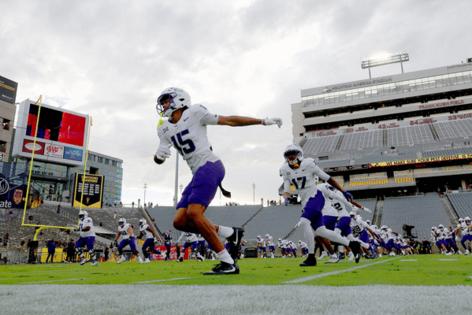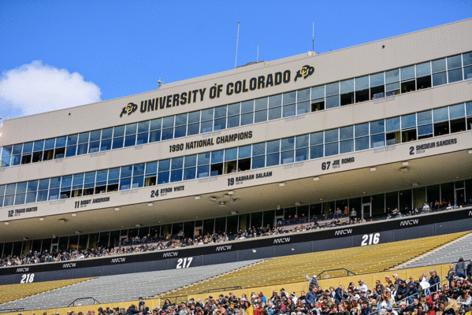A $20,000 football suite with luxe food is latest money machine for colleges
Published in News & Features
Hours before kickoff in a game pitting Arizona State University against Texas Christian University, the atmosphere feels more fine-dining than college football. A chef is carving chili-rubbed prime rib. Nearby, a bartender shakes up this week’s featured cocktail, a tangerine-hued, mango-flavored Spicy Rita.
Those premium offerings at the football stadium in Tempe, Arizona, are free for fans in the most expensive seats, like four-person field boxes that cost $20,000 a year. Upstairs, concession stands are prepping for the proletariat, but even there choices go beyond traditional fare to get a little luxe: $18 pulled-pork sandwiches, $15 birria tacos and a $10 Texas-themed hot dog with cowboy caviar and barbecue sauce — a nod to ASU’s opponent.
Fancy food, bespoke sips and a deluge of alcohol are taking over university stadiums and arenas across the country, becoming a critical source of revenue amid the explosion in money tied to college sports and shift to paying high-profile student athletes. Athletic-department revenue at colleges with top-tier football programs surged to almost $12 billion in 2024, up 32% from a decade earlier even after adjusting for inflation. Schools will pay out some $1.5 billion to athletes this year, marking the first time they’re allowed to directly compensate players, according to Opendorse, a company that helps connect players with sponsorship deals.
To keep the funds flowing, schools are now partnering with outside firms to gussy up their gameday food, looking far beyond the foil-wrapped hamburgers and nachos with orange-colored cheese that were the only options in years past. While high-end food has been a feature of professional sports games for years, college officials now say similar concessions are a crucial part of the hospitality fans expect amid soaring ticket costs. Over the past 25 years, admission prices for sporting events have more than doubled, outpacing inflation.
Danixa Lopez, who has been attending ASU games for six years, is a big fan of the upgrades. “There’s chicken here, there’s pizza there, there are tacos here,” she said before the game, which drew a sellout crowd of 53,774 to see the Sun Devils defeat the nationally ranked TCU Horned Frogs. “They get creative.”
Food-service providers like Sodexo SA, Compass Group Plc and Aramark — which has the contract for ASU sports — are seeking to cash in. The hope is that the fast-growing business could help offset concerns about falling college enrollment and perhaps even revive the companies’ shares, which have underperformed their benchmarks over the past 12 months.
Of the 300 U.S. universities Aramark serves, more than half now include athletic venues in their contracts, a 25% increase in five years. The company expects double-digit growth in collegiate sports revenue this fiscal year, exceeding the median estimate of analysts surveyed by Bloomberg for a 7% increase for the Philadelphia-based company overall.
Sodexo Live!, the unit focused on in-person events at the company based outside of Paris, said the sector is a top priority. The unit's North American revenue rose 9.2% in fiscal 2025 to €1.6 billion ($2.1 billion).
“Today’s fans expect more than a hot dog and a soda,” said Kate Thomson, a marketing executive at the Sodexo unit, which has contracts with the University of Texas and the University of Michigan, among other schools. “Universities view hospitality not only as a service, but as a strategic driver of revenue and brand differentiation.”
UK-based Compass Group Plc, the world’s largest contract caterer, is also ramping up its college sports business in North America, applying the same playbook it uses at professional venues like Major League Baseball’s Wrigley Field and Dodger Stadium.
The company serves colleges including the University of Central Florida, Michigan State University and Stanford University. Revenue from the North American sports and leisure division reached $4.4 billion last year, up 40% from 2019.
Along with the fancier food comes premium prices, which boosts the revenue for both the university and caterer, which typically share profits or operate under a fixed contract. The cost of concessions such as beer, soda, and hot dogs has climbed from two seasons ago, data shared with Bloomberg from sports-betting information site Oddspedia showed. This year, two beers cost an average of $21.40 at games hosted by one of 64 major football programs, up from $16.80 in 2023. At ASU, premium suds cost $16 for 24 ounces.
But the higher costs are part of a broader trend that’s seen Americans grow more comfortable spending on food and drinks away from home. U.S. food-service and bar sales jumped 48% in 2024 from five years prior, about double the pace of inflation during that span, according to Bloomberg Intelligence.
To take advantage of looser purse strings, the University of Cincinnati, a Sodexo customer, repurposed parts of the stadium to generate cash, including an old ticket office that wasn’t being used.
“We gutted it, put a bar in there, and now it’s our speakeasy and it’s turning thousands of dollars a night,” said Anthony Di Fino, the deputy athletics director. The school also briefly converted a storage space into a so-called cocktail potion room at its basketball arena.
To be sure, Di Fino said, the university tries to find a balance between the premium and the familiar. “You can try to do a carving station at each five feet, but then the fans will tell you they want a hot dog,” he added.
Boost to Shares
Recent wins in college sports catering could give food-service companies a much-needed lift. About 60% of U.S. colleges still run sports catering in-house, making them a prime target for food-service providers, according to Stuart Gordon, an analyst at Bloomberg Intelligence.
Shares of Aramark, Compass, and Sodexo have lagged behind broader stock market gains, as the companies await their next growth catalyst amid a stalled return-to-office trend. Sodexo was also hit from earlier contract losses.
College athletics is being touted by the companies as one of the fastest-growing niches of their business, Gordon said. The bet is that sports-related revenue could offset concerns about softer enrollment trends that weigh on university dining contracts, the analyst added.
Joshua Chan, an analyst at UBS AG who has a buy rating on Aramark, said he expects increased revenue from the college sports segment to outpace the company’s overall growth. Even a small bump in sales would “start to move the needle” for shares.
One of the biggest drivers in increased revenue from college sporting events stems from moves to expand sales of alcohol, which a few decades ago was somewhat uncommon at college venues, partly because most students are younger than 21, the legal age to consume booze in the U.S.
But by the mid-2010s, a sizable number of schools had started selling beer and wine, and the list of venues that offer alcohol has only grown since. This year, the University of Nebraska and Clemson University are some of the football powerhouses that joined in. Alcohol alone can generate up to $500,000 in revenue per game at larger venues, Chan estimated.
Allowing alcohol sales basically doubled the average fan spending overnight, according to Jasper Bibb, an analyst at Truist Securities who has a buy rating on Aramark shares. “You went from a $7 hot dog to a $7 hot dog and a $7 beer,” he said.
Those costs can be prohibitive for students and recent grads operating on a budget. Carlos Carranza, a senior at ASU studying finance, said he made sure to load up on food at home before going to the game to avoid stadium prices. Buying beer on site was worth it to enjoy the atmosphere, he said.
Benji Sarnovskiy, a fellow ASU senior studying finance, was tailgating at the parking garage outside the stadium and complaining about the costs. Premium-priced hot dogs? “That’s crazy,” he said. “They sell them on the street for a dollar.”
Adam Ali remembers a different food and drinks scene 25 years ago when he started attending football games as an ASU freshman.
“Just regular hot dogs, hamburgers, nachos, popcorn. Nothing crazy. And no alcohol,” the 42-year-old real estate photographer recalled. Now, he and his wife will easily spend $60 to $70 on food and sodas, and probably closer to $100 after factoring in a couple beers.
©2025 Bloomberg News. Visit at bloomberg.com. Distributed by Tribune Content Agency, LLC.










Comments